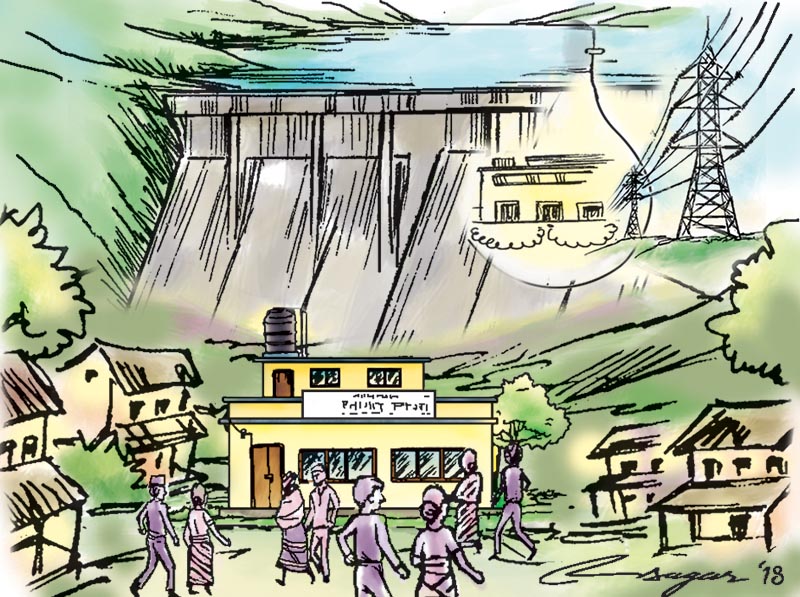Hydropower development: Producing power sans conflict
Increase in electricity production from river flow has fulfilled energy demand of growing population, but hydel projects often become a cause for conflict. Appropriate water allocation is the key to developing hydropower projects without conflict
Hydropower is normally portrayed as an environmentally benign, clean-green, renewable and sustainable source of energy. Yet, conflicts between the proponents and opponents abound in almost all the hydropower projects. Benefit sharing and offering financial share to the people in the affected areas in these projects have been proposed to reduce the degree of conflict.
Scientific and appropriate water allocation for competing demands is the key to developing hydropower projects without conflict. Based on numerous interactions with the stakeholders and analysis of data, including environmental flow (e-flow) assessment and potential climate change impacts on river flow, the Conflict and Cooperation in the Management of Climate Change (CCMCC) Project has developed a simple conceptual model to address the core issue related to hydropower development sans conflict.
One of the major sources of conflict is reduction in water availability when local residents need it. During the monsoon reason, due to abundant rainfall, there is plenty of river flow. Over-abundance of water, in fact, becomes a problem to everyone. However, during the dry season, the scarcity of water in the rivers creates conflict among different water users.
Secondly, long stretches of dry river beds are yet another source of conflict. Compared to the storage type, the run-of-river (ROR) type hydropower projects are considered relatively less damaging to the environment and socio-cultural aspects of the project area. However, when the ROR type projects are constructed in cascade, with the tail-water of the upstream project directly tapped by the downstream project, the stretch of the dry river bed becomes very long and can have a severe adverse effect on the environment and socio-cultural parameters. Similarly, institutional unwillingness to update and implement policies and rules also causes conflict. The institutions involved in the formulation and implementation of the policies, acts and rules related to the hydropower development are aware of the impacts of climate change on river flow and the potential negative impacts from the hydropower plants if the e-flows are not released from the plants. However, the current system of hydropower design process does not require consideration of the impacts of climate change; if a particular hydropower plant is willing to fully comply with the e-flows, there is no mechanism to financially compensate for the reduced energy production. Since the downstream release is not monitored, in effect, the rule breakers are indirectly awarded. When the e-flows are not released from a hydropower plant, the life and livelihood of the downstream residents are adversely affected, which could invite conflict.
Likewise, unpredictable and unwarned sudden increase in the river flow downstream from the tailrace. The storage type and the peaking ROR type hydropower projects release a large volume of water from its tailrace. The release is suddenly stopped when they store water. This on-again off-again release of water at a particular river section, on a daily basis, leads to stress in the life cycle of aquatic living beings. Many people also lose lives when they are caught off-guard due to sudden increase of water. Many local residents find it challenging to coordinate with the dam operators, and the resulting unpredictable and unwarned sudden increase in river flow results in death and damage to properties, including damage to wild life. Some simple steps, however, can be taken to reduce the conflict emanating from disparity in water allocation associated with a typical hydropower plant.
As a part of the outputs of the project, a simple conceptual model for better water allocation has been developed, in consultation with the stakeholders and analysis of data, including e-flow assessment and potential impacts of climate change on river flow. Application of this spreadsheet based model can be used as a tool in roughly estimating the amount of water that will be available in each month for hydropower generation at a particular river section.
Similarly, a mandatory minimum distance between the tailrace of an upstream project and the intake of a downstream project should be set so that the dry river bed length is not very long. This provision enhances better access to the river water and hence reduces conflict between the local residents and the hydropower proponents.
The design guidelines of the hydropower project should clearly mention the requirement of climate change assessment in the water availability for energy generation. This provision will prevent under/over-estimate of design discharge. Similarly, the licensing institute must require the hydropower developers to submit daily gauge height data at river sections upstream of the intake site and downstream of the tailrace site and periodic discharge measurement and sediment sampling data for the entire duration of the licensing period. Additionally, proper e-flows assessment should be conducted before awarding the license.
These provisions will enable proper monitoring of the operation modality of the hydropower plants, encourage the plant operators to abide by the regulations, ensure release of e-flows, and result in reduced conflict.
Shrestha is principal at Nepal Engineering College






